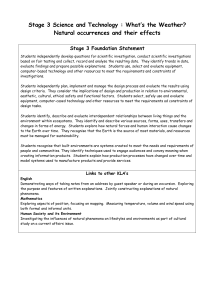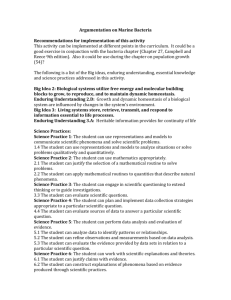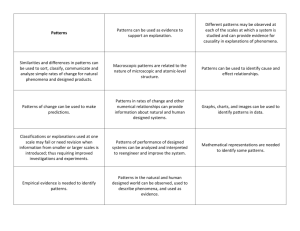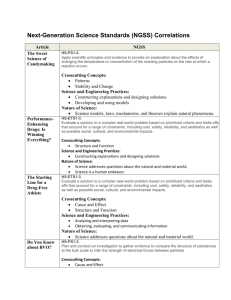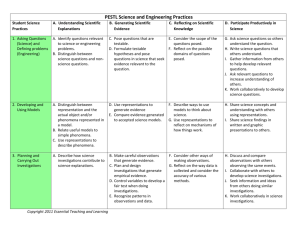Crosscutting Concepts PESTL
advertisement
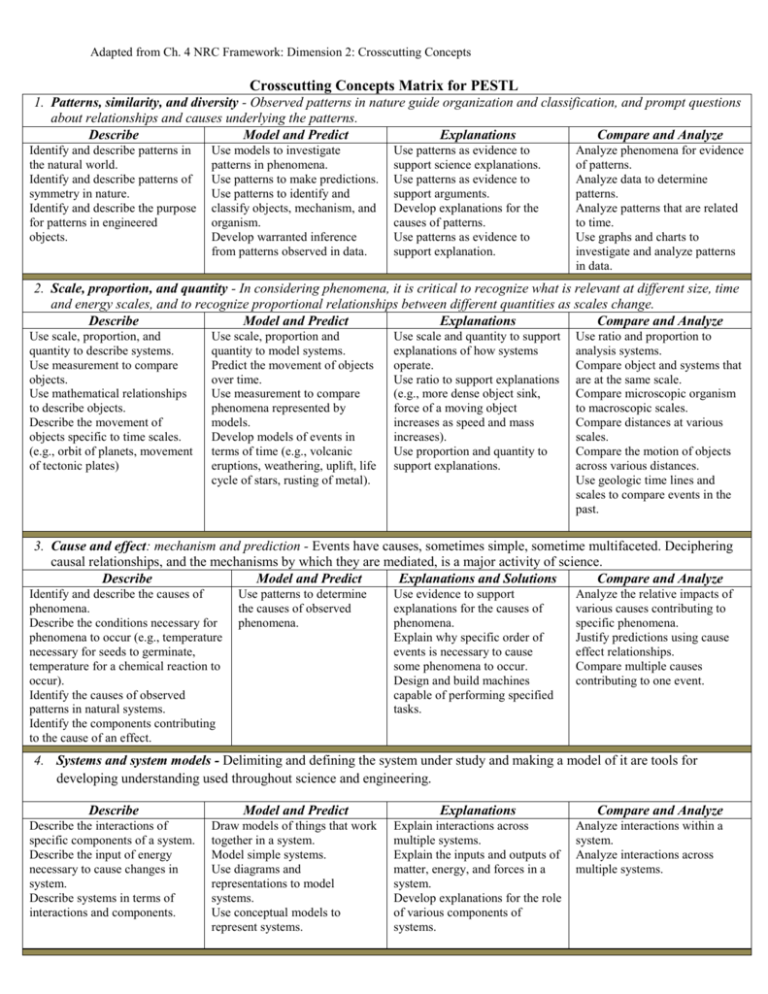
Adapted from Ch. 4 NRC Framework: Dimension 2: Crosscutting Concepts Crosscutting Concepts Matrix for PESTL 1. Patterns, similarity, and diversity - Observed patterns in nature guide organization and classification, and prompt questions about relationships and causes underlying the patterns. Describe Model and Predict Explanations Compare and Analyze Identify and describe patterns in the natural world. Identify and describe patterns of symmetry in nature. Identify and describe the purpose for patterns in engineered objects. Use models to investigate patterns in phenomena. Use patterns to make predictions. Use patterns to identify and classify objects, mechanism, and organism. Develop warranted inference from patterns observed in data. Use patterns as evidence to support science explanations. Use patterns as evidence to support arguments. Develop explanations for the causes of patterns. Use patterns as evidence to support explanation. Analyze phenomena for evidence of patterns. Analyze data to determine patterns. Analyze patterns that are related to time. Use graphs and charts to investigate and analyze patterns in data. 2. Scale, proportion, and quantity - In considering phenomena, it is critical to recognize what is relevant at different size, time and energy scales, and to recognize proportional relationships between different quantities as scales change. Describe Model and Predict Explanations Compare and Analyze Use scale, proportion, and quantity to describe systems. Use measurement to compare objects. Use mathematical relationships to describe objects. Describe the movement of objects specific to time scales. (e.g., orbit of planets, movement of tectonic plates) Use scale, proportion and quantity to model systems. Predict the movement of objects over time. Use measurement to compare phenomena represented by models. Develop models of events in terms of time (e.g., volcanic eruptions, weathering, uplift, life cycle of stars, rusting of metal). Use scale and quantity to support explanations of how systems operate. Use ratio to support explanations (e.g., more dense object sink, force of a moving object increases as speed and mass increases). Use proportion and quantity to support explanations. Use ratio and proportion to analysis systems. Compare object and systems that are at the same scale. Compare microscopic organism to macroscopic scales. Compare distances at various scales. Compare the motion of objects across various distances. Use geologic time lines and scales to compare events in the past. 3. Cause and effect: mechanism and prediction - Events have causes, sometimes simple, sometime multifaceted. Deciphering causal relationships, and the mechanisms by which they are mediated, is a major activity of science. Describe Model and Predict Explanations and Solutions Compare and Analyze Identify and describe the causes of phenomena. Describe the conditions necessary for phenomena to occur (e.g., temperature necessary for seeds to germinate, temperature for a chemical reaction to occur). Identify the causes of observed patterns in natural systems. Identify the components contributing to the cause of an effect. Use patterns to determine the causes of observed phenomena. Use evidence to support explanations for the causes of phenomena. Explain why specific order of events is necessary to cause some phenomena to occur. Design and build machines capable of performing specified tasks. Analyze the relative impacts of various causes contributing to specific phenomena. Justify predictions using cause effect relationships. Compare multiple causes contributing to one event. 4. Systems and system models - Delimiting and defining the system under study and making a model of it are tools for developing understanding used throughout science and engineering. Describe Model and Predict Explanations Describe the interactions of specific components of a system. Describe the input of energy necessary to cause changes in system. Describe systems in terms of interactions and components. Draw models of things that work together in a system. Model simple systems. Use diagrams and representations to model systems. Use conceptual models to represent systems. Explain interactions across multiple systems. Explain the inputs and outputs of matter, energy, and forces in a system. Develop explanations for the role of various components of systems. Compare and Analyze Analyze interactions within a system. Analyze interactions across multiple systems. Adapted from Ch. 4 NRC Framework: Dimension 2: Crosscutting Concepts 5. Energy and matter: flows, cycles and conservation - Tracking energy and matter flows, into, out of, and within systems helps one understand their system’s behavior. Describe Model and Predict Explanations Compare and Analyze Distinguish between the common use of the word energy and the way science uses the word. Describe the transfer of energy. Describe the role of energy in causing changes (e.g., heat evaporates water, energy lifting an object). Use conservation of matter and energy to predict changes in systems. Use models to describe the flow of energy. Use the particle model to describe the cycling of matter. Use energy flow to explain changes in system. Use matter cycles to explain cycles in systems. Explain matter cycles in terms of the flow of energy in systems. Explain the relationship of energy to changes in matter. Analyze the conservation of energy and matter in complex systems. 6. Form and function - The way an object is shaped or structured determines many of its properties and functions. Describe Identify the attributes of a structure that contribute to its stability (e.g., diagonal bracing, spherical share). Relate the structure to the mechanical functioning of a machine or organism. Model and Predict Describe how the materials that objects are constructed from affect the function of the object. Compare the structure of substances in various phases to the way they function. Explanations Explain the function of microscopic structures on organisms Develop explanation for phenomena based on structure and function relationships. Compare and Analyze Use the structure of substances to design and engineer objects with specific capabilities. Investigate phenomena and describe the structure/function relationships. Analyze the design of mechanical systems in terms of structure and function of the system. 7. Stability and change - For both designed and natural systems, conditions of stability and what controls rates of change are critical elements to consider and understand. Describe Model and Predict Explanations Compare and Analyze Distinguish between events that are changing and ones that are stable. Describe stability and change in terms of time scales. Describe systems in terms of stability and change. Identify things that trigger changes to a system that was previously stable. Use models to predict changes in systems that are stable to ones that are changing. Describe systems that are stable over very long periods of time. Use models to describe opposing forces that result in stability. Use models of time scales to investigate changes to systems that seem stable. Copyright 2011 Essential Teaching and Learning Explain changes in a system in terms of inputs and outputs. Explain the necessary attributes of stable systems. Explain patterns of change overtime. Explain phenomena in terms of equilibrium. Compare systems that are stable at one scale and not stable on another scale. Analyze patterns of change and stability. Analyze the attributes of systems that are engineered for stability or controlled change.

